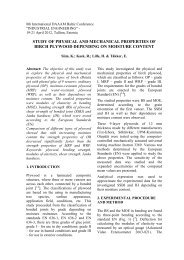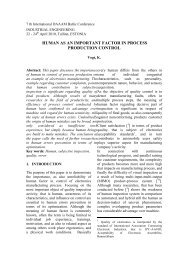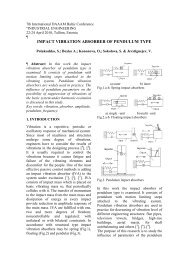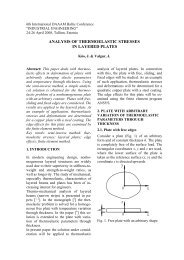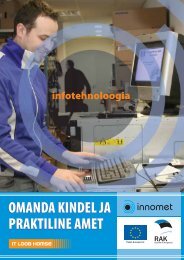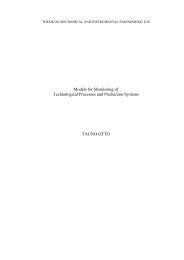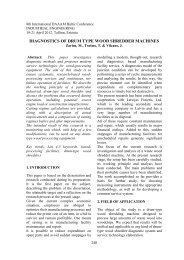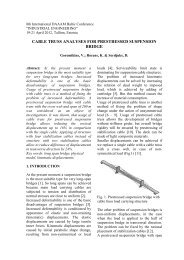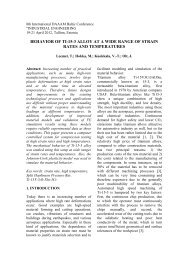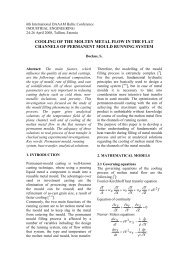Surface Roughness Produced by Hard Turning With Pcbn Tools
Surface Roughness Produced by Hard Turning With Pcbn Tools
Surface Roughness Produced by Hard Turning With Pcbn Tools
Create successful ePaper yourself
Turn your PDF publications into a flip-book with our unique Google optimized e-Paper software.
susceptibility to abrasive wear. Values of<br />
parameters for uncoated tools are nearly<br />
twice the coated. These and subsequent<br />
parameters confirm greater complexity of<br />
machined surface for CB20 than 7020.<br />
In general, hard turning with PCBN tools<br />
provide very smooth and uniform surface.<br />
<strong>Hard</strong> turned surfaces in both cases were<br />
produced with the positive values of<br />
skewness and kurtosis less than 3.<br />
Differences were better distinguished in<br />
waviness profile and parameters.<br />
Complexity of the textures for both<br />
surfaces was described with five different<br />
parameters. 3D images and adequate<br />
contour maps of the surfaces generated <strong>by</strong><br />
hard turning allow distinguishing mixedanisotropic<br />
textures when the random part<br />
was significantly greater for CB20 cutting<br />
tool material.<br />
6. REFERENCES<br />
Fig. 5. Topography images and parameters of<br />
machined surface<br />
Arithmetic mean summit curvature (Ssc)<br />
enables to know the mean form of the<br />
peaks: either pointed, either rounded,<br />
according to the mean value of the<br />
curvature of the surface at these points. The<br />
value of Ssc for CB20 cutting tool material<br />
is greater and increases with cutting time.<br />
Developed interfacial area ratio (Sdr)<br />
describes the complexity of the surface<br />
thanks to the comparison of the curvilinear<br />
surface and the support surface. A<br />
completely flat surface has a Sdr near 0%.<br />
Sdr is of 33.1% for CB20 cutting tool<br />
material and only 9.41 for 7020 cutting<br />
tool material. The difference increases with<br />
cutting time.<br />
5. CONCLUSIONS<br />
Based on the experimental results, 2D and<br />
3D parameters of the surface produced <strong>by</strong><br />
hard machining with PCBN coated and<br />
uncoated tools were selected and analysed.<br />
1. Zawada-Tomkiewicz A., Application of<br />
machined surface image analysis for<br />
identification of suitable parameters of<br />
turning as a pre-operation, 12th<br />
International Conference on Metrology and<br />
Properties of Engineering <strong>Surface</strong>s,<br />
Rzeszow 2009 167-171<br />
2. W. Grzesik, T. Wanat, Comparative<br />
assessment of surface roughness produced<br />
<strong>by</strong> hard machining with mixed ceramic<br />
tools including 2D and 3D analysis,<br />
Journal of Materials Processing<br />
Technology 169 2005 364–371<br />
3. W.P. Dong, P.J. Sullivan and K.J. Stout,<br />
Comprehensive study of parameters for<br />
characterizing three dimensional surface<br />
topography. III. Parameters for<br />
characterizing amplitude and some<br />
functional properties, Wear 178 1994 29–43<br />
4. Stout, K.J., Sullivan, P.J., Dong, W.P.,<br />
Mainsah, E., Luo, N., Mathia, T.,<br />
Zahouani, H. 1994, The Development of<br />
Methods for the Characterisation of<br />
<strong>Roughness</strong> in Three Dimensions,<br />
Publication no. EUR 15178 EN of the<br />
Commission of the European<br />
Communities, Luxembourg, ISBN 0 7044<br />
1313 2:1-358



